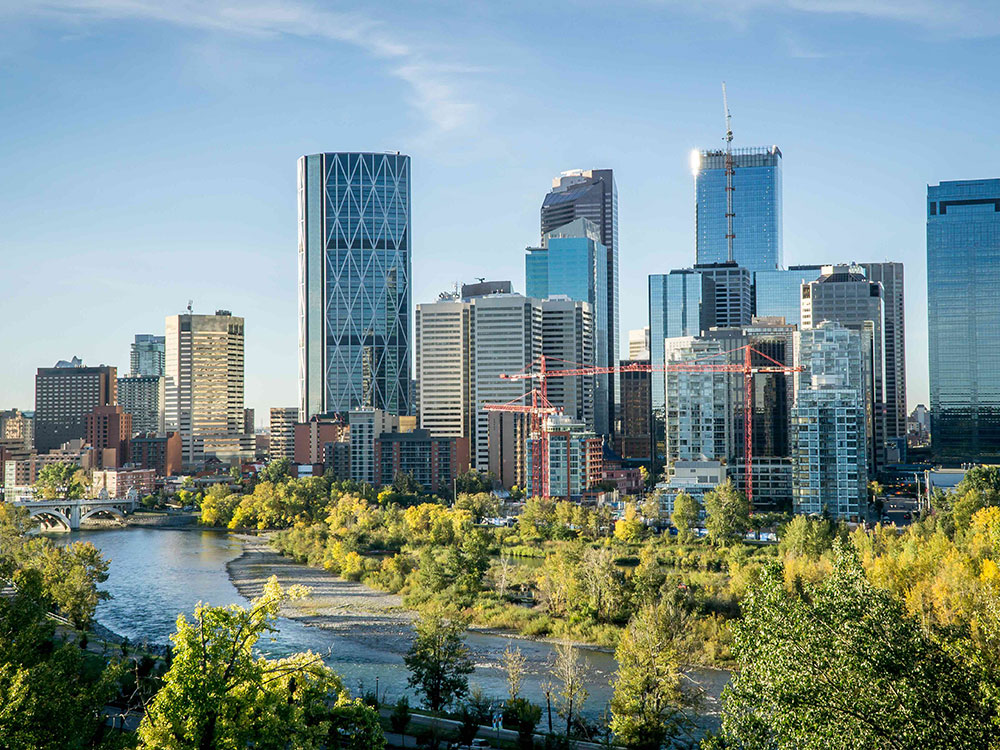When oil prices tanked in 2014, office vacancy rates in downtown Calgary took off, and their ascent has remained steady — rising from six per cent a decade ago to just over 30 per cent in the last quarter of 2023. In the wake of the pandemic, this trend has spread across Canada’s largest cities, though to a lesser extent.
Record-high office vacancy rates drove a steep decline in property values, which resulted in a $300-million drop in tax revenue. So in 2021, the City of Calgary launched an ambitious plan to subsidize the conversion of six million square feet of vacant office space into residential use.
Allocating $75 per square foot to incentivize the adaptive reuse of outdated office space has been touted as a win-win solution that Calgary Mayor Jyoti Gondek said will offer “homes and amenities for Calgarians and visitors alike” while “strengthening the economic engine of the city.”
Many experts agree. In a 2023 report, the Canadian Urban Institute suggests that investment in office conversions not only supports developers and building owners, but also helps revitalize downtowns, increase housing choice and save resources by extending the lifespan of an obsolete asset.
According to Jenna Dutton, an urban planner and co-author of a briefing paper that influenced Calgary’s program, office conversions to affordable housing “give people the option [to live] in areas that may have better access to transit and walkability.”
But without adequate policies and funding, not everyone wins.
Office-to-residential conversions can harm the health and wellness of residents, especially when it comes to housing equity-deserving populations, says Alison Grittner, a spatial justice researcher and assistant professor of social work at Cape Breton University.
“The fundamental issue with office-to-residential conversions is the deep floor plates,” she says, referring to the distance between a building’s windows and its core. “You can’t get the daylight and ventilation you need without it being really expensive.”
After an initial municipal investment of $153 million, and 17 conversion projects in the queue, funding for Calgary’s downtown development incentive dried out in October. To reinvigorate the program’s coffers, the city will use a portion of the $228 million granted by Canada Mortgage and Housing Corp.’s Housing Accelerator Fund to create 1,050 affordable homes in vacant office space, a move supported by the city’s newly minted affordable housing strategy. The CMHC has extended the program to nine municipalities across Canada, but just two in B.C. and Alberta: Kelowna and Calgary.
“The city’s office conversion program is focused on bringing housing online downtown as quickly as possible including market, below market and, when applicable, CMHC-defined affordable housing units,” the City of Calgary told The Tyee in an email statement. CMHC defines affordable housing as those units whose monthly rent costs less than 30 per cent of a household’s pre-tax income.
In addition, after two disappointing attempts in prior budget cycles, city council is once again asking the provincial government to support the program. This time the ask is for $160.5 million to “further leverage local, private investment, towards converting underutilized office space to residential uses, including new affordable housing, seniors’ housing and student housing.”
The United Conservative Party government has contributed $5 million for downtown revitalization since 2022. Last year, Alberta Premier Danielle Smith cited concerns with office conversions.
“It is a little complicated for me to explain why I would give $100 million to a Toronto-based REIT [real estate investment trust] so that they can renovate their building. I accept that that's a bit of a complicated argument to be made,” Smith said in a March press conference last year.
In this context, supporting the creation of affordable housing would be an easier pill to swallow for the politicians holding the purse strings. But whether the funds allocated to this program are sufficient to provide a supportive living environment for lower-income Calgarians remains in question.
“I do appreciate and understand the importance of adaptive reuse, especially if they’re older, concrete buildings,” says Grittner, who’s also trained as an architect. “But making them quality and habitable can be more expensive than building a new building.”
Adaptive reuse projects are a difficult endeavour, evident from the cost of the conversions.
Depending on the specific characteristics of an office building — including the size of the floor plate, type of structure and building envelope — the cost of converting an office tower to residential can surpass US$500 per square foot, whereas the construction cost of traditional highrise apartment buildings in Canada ranges between C$180 and C$460 per square foot.
More importantly, without sufficient capital, some of the same issues that drove commercial tenants away from these office buildings are likely to affect future residents. After all, the reason office vacancy is concentrated in older buildings is that today’s commercial tenants seek spaces that support the health of office workers with access to daylight and fresh air.
Because in the ’80s and ’90s office buildings were designed to accommodate large swaths of cubicles, the distance between a building’s envelope and its core — usually occupied by elevators and washrooms — tends to be larger than in a typical residential building.
To make the financials work for a project, a certain number of units is required per floor, which results in a layout of long and skinny apartments. As a result, providing access to daylight and natural ventilation to all living spaces at a reasonable cost is a challenging, if not impossible, endeavour.
In Calgary, the two office-to-residential conversions completed so far in the city’s core, Neoma, formerly Sierra Place, and the Cornerstone, have resulted in apartments where some of the bedrooms lack windows.
While this situation is often underplayed as a lifestyle preference, research shows that the health impacts of inboard or windowless bedrooms can be significant — especially for equity-deserving populations.
“This is not the kind of housing that any of us, if we can afford it, would live in,” Grittner says, pointing at evidence of detrimental effects of insufficient exposure to daylight on people’s health, which includes eye conditions and mood disorders.
Moreover, researchers have found that the presence of windows with an outdoor view creates a sense of safety and control over one’s environment, an important aspect to consider when designing affordable housing.
“When you look at vulnerable populations, who would most likely be living in this type of housing, it’s incredibly important that they have a restorative and nature-connected space,” Grittner says, emphasizing the significance having a connection to the outdoors represents for people living in affordable and supportive housing.
“One of the cornerstones of trauma-informed design is enabling a connection to the outdoors, and understanding the impact of the quality of housing, as well as the surrounding environment.”
Because the City of Calgary plans to use both federal and provincial funding to convert vacant office space into affordable housing, it seems reasonable to require that the resulting homes be a supportive living environment.
Pointing to Rotterdam as a jurisdiction that has implemented requirements to prevent the creation of substandard housing when converting office towers to homes, Dutton notes that, just like housing equity-deserving populations is more cost-effective than Band-Aid solutions, “there should be an understanding of the broader cost to society of poorly designed buildings, even if it seems more expensive.”
The Tyee reached out to the City of Calgary’s media relations office to speak to someone about the potential impacts on residents of the office conversion projects but was not connected to anyone for comment.
In the face of Calgary’s affordable housing supply shortage, removing any potential barriers to the creation of new housing is a priority. In such context, access to daylight can be perceived as a nice-to-have, rather than a human necessity.
“Mandating windowed bedrooms would add to the already existing site constraints,” suggests Joel Laforest, policy and communications adviser for Calgary Coun. Courtney Walcott. The Tyee contacted Laforest to speak with Walcott but was told he wasn’t available for an interview.
Calgary isn’t alone in allowing windowless bedrooms to proliferate in the name of affordability.
Vancouver has been trialling this configuration in affordable housing since 2020. And last year, New York City’s mayor, Eric Adams, caused a stir after suggesting windowless bedrooms should be legal again, 156 years after they were banned, largely because of health and safety issues.
In the United Kingdom, deregulated adaptive reuse of vacant office buildings in 2013 led to the production of tens of thousands of substandard homes. Despite recent changes to the regulations, both community members and experts have continued to raise concerns.
As cities across Canada seek to follow Calgary’s lead, decision-makers should ensure office conversions produce a living environment that supports the health and well-being of residents, and look beyond the reduction of office vacancy rates as a measure of success.
“I don’t think that there’s anything ostensibly harmful about this program,” Grittner says. But conversions should create an environment that supports the health of residents. “If we don’t understand housing quality and neighbourhood context, we are really setting out vulnerable communities to continue to experience intergenerational poverty and oppression.
“There’s nothing preventing us from doing these office conversions in a way that creates life-supporting habitats that people would love to live in. It’s just a question of how we’re doing it, and how much money are we spending on it.” ![]()
Read more: Alberta, Housing, Urban Planning

















Tyee Commenting Guidelines
Comments that violate guidelines risk being deleted, and violations may result in a temporary or permanent user ban. Maintain the spirit of good conversation to stay in the discussion and be patient with moderators. Comments are reviewed regularly but not in real time.
Do:
Do not: